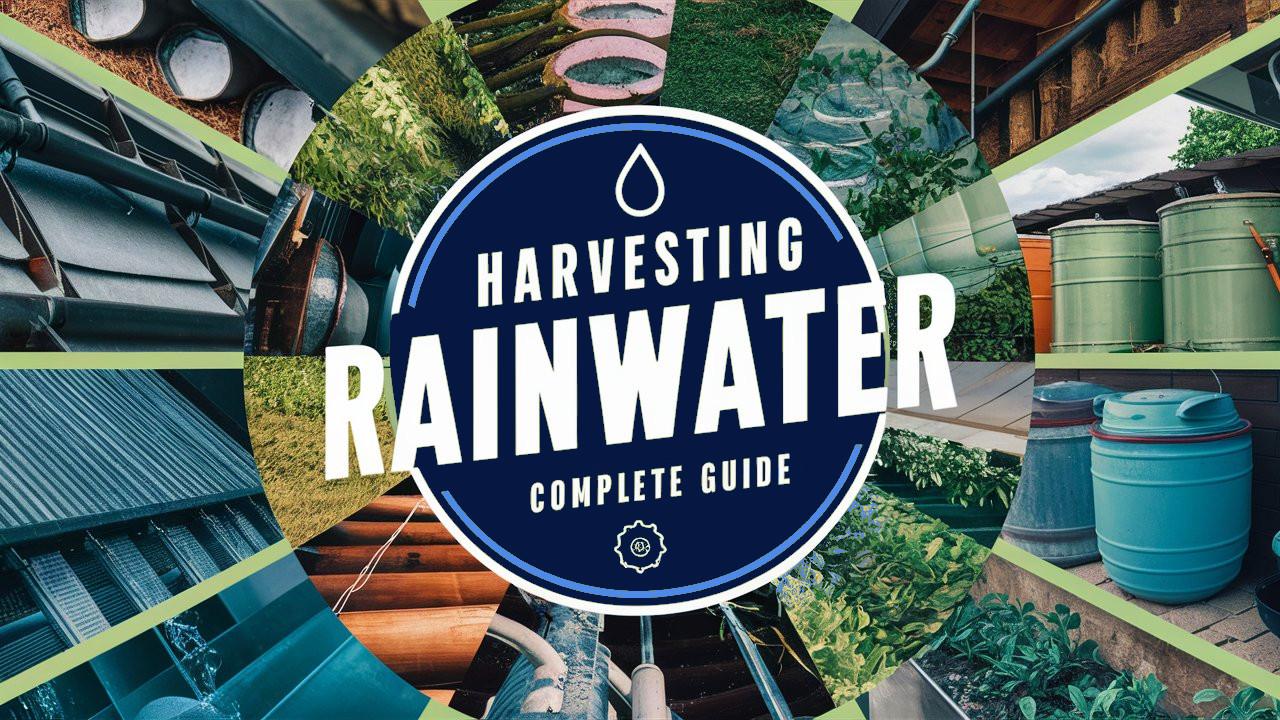In this comprehensive guide, we will explore the techniques of rainwater harvesting, its benefits, fundamental components, and a detailed breakdown of individual materials needed to implement a rainwater harvesting system effectively.
Benefits of Rainwater Harvesting
Before diving into the components of rainwater harvesting systems, it’s essential to understand the benefits this practice brings.
Rainwater harvesting is an age-old practice that has seen a resurgence as communities focus on sustainable water management strategies. This practice involves capturing and storing rainwater for reuse, which can help conserve water, reduce utility bills, and mitigate flooding.
Water Conservation: Harvesting rainwater can significantly reduce dependence on municipal water supplies, especially in areas facing irregular rainfall or water scarcity.
Sustainable Water Supply: It offers an alternative source of water for irrigation, flushing toilets, and even potable water (with appropriate treatment), contributing to water security.
Cost Savings: Utilizing rainwater can lead to reduced water bills, particularly for households and businesses that need substantial water for gardening, washing cars, or filling pools.
Environmental Protection: Rainwater harvesting reduces stormwater runoff, which can lead to erosion and pollution in local waterways.
Groundwater Recharge: When managed correctly, rainwater harvesting can assist in replenishing groundwater supplies by allowing water to infiltrate the ground.
Types of Rainwater Harvesting Systems
When considering a rainwater harvesting system, it’s crucial to select one based on your specific needs and environmental conditions. Here are the two primary types:
Active Systems: These rely on pumps and electrical systems to move and distribute water. They are more complex and may require more maintenance.
Passive Systems: Passive systems make use of gravity to facilitate water flow without pumps, generally requiring less maintenance and offering a simpler setup.
Key Components of Rainwater Harvesting
To successfully implement a rainwater harvesting system, several crucial components must be integrated. These elements work together to ensure the efficiency and effectiveness of your system.
Catchment Surface
The catchment surface is the first and essential component of a rainwater harvesting system. This is typically the roof area where rainwater first makes contact.
Considerations:
Material: Choose a roofing material that is conducive to rainwater collection. Metal, tiles, and certain types of shingles are ideal because they allow for cleaner water and are non-toxic.
Size: The larger the catchment area, the more rainwater can be collected. Ensure that your roof is well maintained with no leaks to maximize collection potential.
Gutters and Downspouts
Gutters and downspouts are vital for channeling the rainwater from the catchment area into the storage system.
Considerations:
Material: Use non-toxic materials such as aluminum or PVC for gutters and downspouts to avoid contaminating harvested water.
Installation: Ensure gutters slope properly towards the downspouts to prevent any standing water, which can lead to blockages.
Maintenance: Clean gutters regularly to remove debris and ensure optimal water flow.
First Flush Diverters
A first flush diverter is a device that diverts the initial runoff from the roof, which often contains the highest concentration of contaminants, away from the storage tank.
Considerations:
Installation: Place the diverter at the beginning of the downspout so that it effectively directs the first few liters of water away from the tank.
Maintenance: Regularly check and clean the diverter to ensure that it functions properly to prevent contaminants from entering the storage tank.
Storage Tank
The storage tank is where collected rainwater is stored for later use.
Considerations:
Material: Options include plastic, fiberglass, and concrete. Food-grade poly tanks are recommended for safety and preservation of water quality.
Size: The size of the tank should be based on expected rainfall, roof catchment area, and water usage. A larger tank will better accommodate larger amounts of rainwater.
Location: Position the tank close to the catchment area for efficient water transfer, while also ensuring that it is accessible for maintenance.
Filtration System
To ensure rainwater is suitable for its intended use, a filtration system is necessary to remove debris, sediment, and contaminants.
Considerations:
Pre-Filter: Use screen filters at the canopy of the rainwater system to catch leaves and larger debris.
Post-Filter: For indoor use or irrigation, consider finer filters to further purify the water before it reaches taps or irrigation systems.
Pump
In active rainwater harvesting systems, a pump is essential to distribute the collected rainwater to various points of use, whether for irrigation, potable use, or household applications.
Considerations:
Type of Pump: Submersible pumps or surface pumps are common choices. Submersible pumps are placed in the storage tank and can be used for drinking water applications, while surface pumps draw water from above the tank and are typically used for irrigation.
Capacity: Choose a pump with sufficient capacity to meet the desired flow rate and pressure for its intended applications. Consider the height the water needs to be pumped to ensure proper functioning.
Automation: Installing an automatic control system can provide the convenience of activating the pump only when water is needed, thus saving energy and reducing wear.
Distribution System
The distribution system is the network of pipes or hoses that transport harvested rainwater from the storage tank to its points of use.
Considerations:
Material: Use non-toxic materials, such as PVC or polyethylene, to ensure that the water quality is not compromised during transport.
Gravity vs. Pump: If the system is designed to rely on gravity, ensure that the tank is elevated to provide adequate water pressure. If using a pump, ensure that the pipe size matches the pump’s specifications to avoid pressure loss.
Additional Components: Consider adding a pressure tank to maintain consistent pressure in the distribution system, especially for homes using rainwater for various domestic purposes.
Water Treatment Systems
If rainwater is being used for potable purposes, additional treatment systems must be employed to ensure safety.
Considerations:
Filtration Methods: Employ various filtration methods such as activated carbon filters, reverse osmosis systems, or ultraviolet (UV) treatment to remove pathogens and ensure water quality.
Regular Testing: Incorporate routine water quality testing to monitor for contaminants and ensure that treatment methods are effective. Testing should include checks for harmful microorganisms, heavy metals, and chemical pollutants.
Steps to Set Up a Rainwater Harvesting System
1.Planning and Design
Before proceeding with installing a rainwater harvesting system, thorough planning is necessary.
Assess Usage Needs: Understand how much rainwater you will need based on your household’s requirements. This includes water for irrigation, flushing toilets, and potentially drinking.
Evaluate Local Regulations: Check local laws or regulations regarding rainwater harvesting, as some regions have specific guidelines or incentives.
Calculate Harvesting Potential: Using the dimensions of your catchment area and local rainfall patterns, estimate how much rainwater you can capture.
2. System Installation
Once the design is finalized, gather materials and start the installation process.
Install the Catchment Area: If modifications to the roof are necessary, ensure that new materials comply with health standards.
Set Up Gutters and Downspouts: Install gutters and downspouts that effectively channel rainwater into your storage tank.
Install the Storage Tank: Position the storage tank in a convenient and safe location, ensuring proper seals and connections for systems involving pumps.
Integrate Diversion and Filtration Systems: Install first flush diverters and filtration systems to maintain water quality.
Connect the Distribution and Pump Systems: If utilizing an active system, correctly install the pump and associated piping to ensure efficient water distribution.
3. Maintenance and Upkeep
Maintain your rainwater harvesting system to ensure long-term sustainability and functionality.
Regular Cleaning: Clean gutters, filters, and storage tanks to prevent blockages and contamination. Depending on local conditions, this might need to be done seasonally or more frequently.
Inspect System Components: Routinely check the condition of pipes, tanks, and pumps for leaks, wear, or corrosion.
Monitor Water Quality: Test the harvested rainwater periodically to check for pathogens, sediments, and contaminants, especially if used for drinking purposes.
Conclusion
Rainwater harvesting presents an effective solution for sustainable water management, capable of reducing reliance on municipal supplies and contributing to water conservation efforts. By understanding the essential components and materials required to establish an effective rainwater harvesting system, individuals and communities can implement systems that not only address water scarcity but also promote environmental protection.
With proper planning, installation, and maintenance, harvesting rainwater can become an invaluable resource in any setting, leading to significant water savings and promoting a sustainable approach to water usage. Whether for DIY enthusiasts or large-scale implementations, the benefits of rainwater harvesting are clear—it’s time to embrace the power of our most precious resource: rain.















